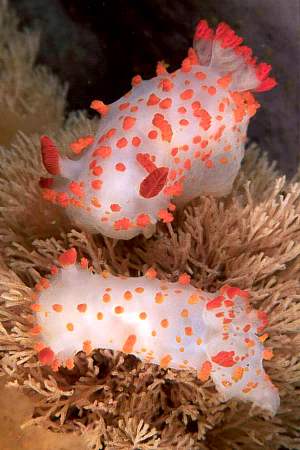

Triopha catalinae
(Cooper, 1863)
Order: NUDIBRANCHIA
Suborder: DORIDINA
Superfamily: ANADORIDOIDEA
Family: Polyceridae
Subfamily: Triophinae
DISTRIBUTION
West coast of North America from Alaska to Mexico. Also reported from Japan, and in Forum from Sth Korea.
PHOTO
UPPER: San Miguel Island, Channel Islands National Park, California - July 2003, on Bugula, one of the bryozoans it eats. Photo: Bruce Wight
LOWER: W. Anacapa Island in approx. 8 m depth on a vertical wall of a rock [off Los Angeles, California, USA]. Approx 20mm long. Photo: Daniel Geiger.
Grows up to 70mm long. Reported to feed on a number of bryozoans, including Bugula mollis, Caulibugula ciliata, Cellaria mandibulata, Crisia spp., Dendrobeania lichenoides and Scrupocellaria spp.
Reference:
• Cooper, J.G. (1863). On new or rare mollusca inhabiting the coast of California. 2. Proceedings of the California Academy of Sciences, 3: 56-60
Rudman, W.B., 1999 (December 21) Triopha catalinae (Cooper, 1863). [In] Sea Slug Forum. Australian Museum, Sydney. Available from http://www.seaslugforum.net/find/triocata
Related messages
Re: Mating Triopha catalinae from Canada
July 14, 2008
From: Glen Miller
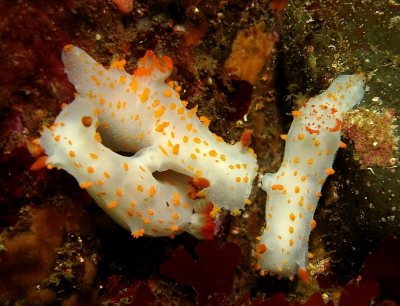
Concerning message #14241:
Thought this additional photo of mating Triopha catalinae may be of interest seen the 3rd animal extending its mating tube (what is the proper anatomical name for this structure?)
Locality: NW Coast, Vancouver Island, 50 feet, British Columbia, Canada, Pacific Ocean, 06 July 2008, Wall . Length: 12 cm. Photographer: Glen Miller.
Glen Miller
earthlingenterprises@telus.net
Miller, G., 2008 (Jul 14) Re: Mating Triopha catalinae from Canada. [Message in] Sea Slug Forum. Australian Museum, Sydney. Available from http://www.seaslugforum.net/find/21683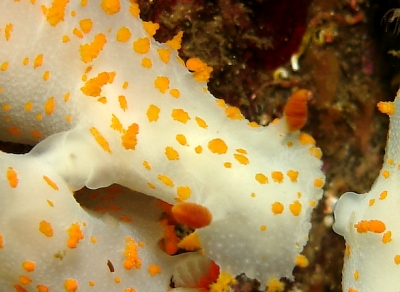
Thanks Glen,
Your question is an interesting one. The answer is complicated because firstly, as you know, these animals have a full set of male and female organs and secondly, the actual copulatory organs are in a different place when they are functioning than they are the rest of the time. To keep it as simple as possible I will just deal with Triopha, and related nudibranchs in which both male and female organs are found in much the same part of the body. When you dissect a preserved Triopha there is a genital pore on the right side of the body which opens into a small sac, which is called the genital vestibule. There are three openings into this sac, one of which is the male penial opening, and the other two are female openings, one which receives the penis of the partner, and the other which deposits the fertilised eggs in the typical egg ribbon. It's hard to call one of these the vagina, as in mammals there is a single duct which performs both these functions. So the first problem is what to call the ducts. The second problem is that things look quite different during copulation. The genital vestibule turns inside out so that what is a sac in a preserved, or non-mating animal, is a raised 'tube' as you described, in a mating animal. The penial opening effectively disappears as a hole, because the penial apparatus which has been tucked inside the body cavity is pushed out so that it can enter the appropriate female duct of its partner.
I tend to skirt around the problem by talking about the everted genital organs or genital apparatus. There is no problem talking about the everted penis, but in species like Triopha with two female openings, calling the opening that the penis enters the vagina, leaves the 'egg duct' without a name. There are other dorids and nudibranchs in which there is only one female duct. In those cases, calling the common female duct the vagina seems perfectly appropriate. I know this doesn't give you a satisfactory answer - perhaps if you want a descriptive term to describe what you can see in the photo, ' everted mating organs' is the answer, because it could apply to nudibranchs with one or two female genital ducts.
Best wishes,
Bill Rudman
Mating Triopha catalinae from Canada
July 13, 2005
From: Paul Sim
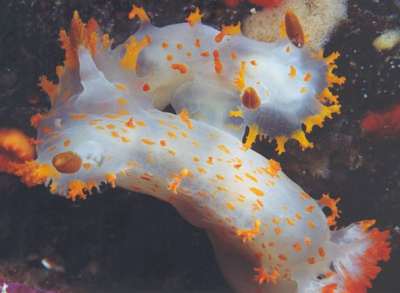
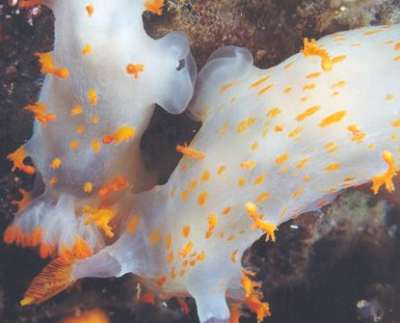
Hi Bill,
I thought I might share this mating spectacle I happened on one day.
Locality: Johnson Point, Seymour Inlet, British Columbia, Canada. Pacific Ocean. Depth: 50 feet. Length: 2 inches. 09 September 2004. rocky bottom. Photographer: Paul Sim
This pair of Triopha catalinae seemed pretty oblivious to my paparazzi-like invasion so I kept blazing away with the strobes and came away with these. The darndest thing was that while I was watching their very sensual display (rubbing and rearing up on one another) I couln't help but think they were enjoying themselves. Could these primitive animals have emotions?
Paul Sim
plsim@shaw.ca
Sim, P., 2005 (Jul 13) Mating Triopha catalinae from Canada. [Message in] Sea Slug Forum. Australian Museum, Sydney. Available from http://www.seaslugforum.net/find/14241
Dear Paul,
I guess one problem with animal behaviour studies is the ease with which we can transfer our emotions and behaviours to those of the animals being observed.
However if you follow the 'selfish gene' theory of evolution which proposes that the main aim of an organism is to pass on its genes to the next generation, then you would expect organisms to evolve ways of encouraging such behaviour. Whether a slug's response to various stimuli can be described as pleasure or pain is beyond me, although I am sure that as we speak there are a whole army of scientists out there with microprobes embedded in mollusc nerve cells studying such things. There is a serious side to this work however. Dr Eric Kandel has recently received the Nobel Prize for pioneering work he did, sticking microprobes into the ganglia of Sea Hares, to develop theories on learning.
Thanks for the photos,
Bill Rudman
Brownish colour form of Triopha catalinae
May 10, 2005
From: Paul Sim
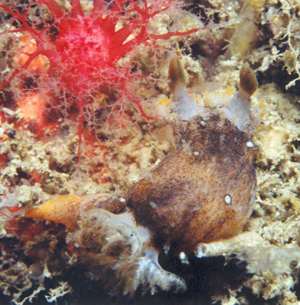
Hi Bill,
Please help ID this Triopha. Some people locally think it a variation of Triopha catalinae. I've only seen it twice but each time it has been a brownish base color. I include two individuals for your perusal.
Locality: Whytcliff Marine Park, British Columbia, Canada. Pacific Ocean.
Depth: 50 feet. Length: 1 inch. 06 October 2004. wall. Photographer: Paul Sim
Thanks,
Paul
plsim@shaw.ca
Sim, P.D., 2005 (May 10) Brownish colour form of Triopha catalinae. [Message in] Sea Slug Forum. Australian Museum, Sydney. Available from http://www.seaslugforum.net/find/13733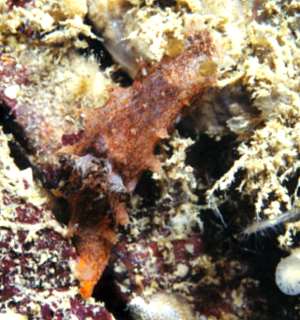
Dear Paul,
I would agree that it looks rather different from Triopha catalinae. It is the animal called Triopha sp. 1 in Behrens, 1991. According to Behrens (2004) Sandra Milen has looked at its anatomy and decided it is a colour form of Triopha catalinae. Specimens of this colour form are noted by Behrens from Washington, British Columbia and Alaska
-
Behrens, D. W. (1991) Pacific Coast Nudibranchs. Monterey, California, Sea Challengers. 107pp.
-
Behrens, D. W. (2004) Pacific Coast Nudibranchs, Supplement 2. New species to the Pacific Coast and new information on the oldies. Proceedings of the California Academy of Sciences, 55: 11-54.
Best wishes,
Bill Rudman
Triopha catalinae from California
August 9, 2004
From: Bruce Wight

Hi Bill,
Here is a photo of Triopha catalinae I took on a trip to San Miguel Island [Channel Ids, California] in July 2004.
Bruce Wight
bruce.c.wight@boeing.com
Wight, B.C., 2004 (Aug 9) Triopha catalinae from California. [Message in] Sea Slug Forum. Australian Museum, Sydney. Available from http://www.seaslugforum.net/find/12716Thanks Bruce,
Bill Rudman
Clown slugs
February 4, 2004
From: Jimmy
My name is Jimmy and I am in 4th grade. I am doing a report on the Clown Sea Slug. What family are they from? What do they eat? Do you have any pictures of them? Do they sleep? Do you have any more interesting facts about them?
Thank you.
Jimmy
adamsfamle@earthlink.net
Jimmy, 2004 (Feb 4) Clown slugs. [Message in] Sea Slug Forum. Australian Museum, Sydney. Available from http://www.seaslugforum.net/find/12114Dear Jimmy,
I guess the nudibranch you are interested in is Triopha catalinae which is found on the west coast of North America and is often called the Clown Nudibranch. As well as being found from Mexico to Alaska, it has also been found once in Japan and if you look at the other messages on the Forum, it has also been found in Korea.
We don't know much about its biology but have a look at the species' Fact Sheet for some information. Also have a look at the other messages on the Forum about this species, which are attached below your message on this page for some more information. For example the message directly below your message has a photo of one laying its egg ribbon. I am not sure if they sleep, but nudibranchs are quite often found nestled in a crevice, not moving, so I guess that could count as sleeping.
Good luck with your project
Bill Rudman
Triopha catalinae laying eggs
November 27, 2003
From: Ken Ashman

Dr. Rudman -
Here is a photo of Triopha catalinae laying eggs. I came across the slug at San Miguel Island, California, at about 35ft.
Ken Ashman
kenashman@charter.net
Ashman, K., 2003 (Nov 27) Triopha catalinae laying eggs. [Message in] Sea Slug Forum. Australian Museum, Sydney. Available from http://www.seaslugforum.net/find/11521Thanks Ken,
It's good to get a photo of the egg ribbon of this species.
Best wishes
Bill Rudman
Triopha catalinae from Channel Ids, California
August 4, 2003
From: Bruce Wight

Dear Bill,
Johanna and I saw lots of great natural behavior on last weekends dive trip out to San Miguel Island [Channel Islands National Park, California - July 2003]. Here is one of a series of messages showing some images I took during the two day trip.
This is of two Triopha catalinae nudibranchs feeding on Bugula.
Hope you enjoy the images,
Bruce Wight
bwproductions@earthlink.net
Wight, B., 2003 (Aug 4) Triopha catalinae from Channel Ids, California. [Message in] Sea Slug Forum. Australian Museum, Sydney. Available from http://www.seaslugforum.net/find/10654Thanks Bruce,
Bill Rudman.
Juvenile Triopha catalinae? from Brit. Columbia
October 8, 2002
From: Marli Wakeling

Hi Bill,
I found this tiny critter at Port Hardy, and first thought it might be something new. Once I enlarged it, it appears that it may be a juvenile Triopha catalinae.
Location: Annie's Wall, Port Hardy, British Columbia, Canada.
Date: August 2002
Depth: 50 feet
Length: 1 cm.
Photograph: Marli Wakeling
Regards,
Marli
scubamarli@excite.com
Wakeling, M., 2002 (Oct 8) Juvenile Triopha catalinae? from Brit. Columbia. [Message in] Sea Slug Forum. Australian Museum, Sydney. Available from http://www.seaslugforum.net/find/8136Dear Marli,
I think you're right. It certainly looks like it could grow into Triopha catalinae with an extra bit of orange her and there.
Best wishes,
Bill Rudman
Re: Triopha catalinae from Korea
July 10, 2002
From: Dave Behrens
Dear Bill & Dong Bum,
Just to confirm Bill's identification of your animal as Triopha catalinae. It is a very interesting record. Thank you for sending your note to the Forum. Your contribution helps us all.
My best regards,
Dave Behrens
dave@seachallengers.com
Behrens, D., 2002 (Jul 10) Re: Triopha catalinae from Korea. [Message in] Sea Slug Forum. Australian Museum, Sydney. Available from http://www.seaslugforum.net/find/7486Triopha catalinae from Sth Korea
July 6, 2002
From: Dong Bum, Koh

Dear Bill,
Thank you very much for your help. I`ve no idea about a this photo. Can you give me any information about this?
Data:
September. 2001
Seong San (East coast of Cheju island, South Korea) Depth: 22m. Photo: Dong Bum,Koh
Dong Bum,Koh
drkoh@seasee.co.kr
Koh, D.B., 2002 (Jul 6) Triopha catalinae from Sth Korea. [Message in] Sea Slug Forum. Australian Museum, Sydney. Available from http://www.seaslugforum.net/find/7391Dear Dong Bum,
Unless I am very mistaken this is Triopha catalinae which is a well known species in California. In North America it has been recorded from Alaska to Baja California. Baba (1957) also records it once from northern Japan. This is a very interesting find, confirming its presence in the NW Pacific.
• Baba, K. (1957) A revised list of the species of Opisthobranchia from the northern part of Japan, with some additional descriptions. Journal Faculty Science, Hokkaido Imperial University, series 6, Zoology, 13: 8-14.
Best wishes,
Bill Rudman
Triopha catalinae from California
July 20, 2001
From: Ken Tucker


Thought you might like another photo of this beast.
Taken July 1995, Begg Rock, off San Nicolas Island, in the Channel Islands, central coast of California, USA.
Ken Tucker
Ken@kilili.com
Tucker, K., 2001 (Jul 20) Triopha catalinae from California. [Message in] Sea Slug Forum. Australian Museum, Sydney. Available from http://www.seaslugforum.net/find/4872Thanks Ken,
By amazing coincidence both your photos and Daniel Geiger's message arrived on the same day. This beautiful animal cetainly deserves a few beautiful photos.
Best wishes,
Bill Rudman
Triopha catalinae from Los Angeles
July 20, 2001
From: Daniel Geiger

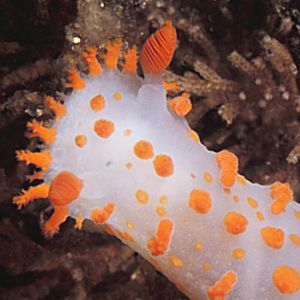
Hi Bill,
attached is a Triopha catalinae, found off Los Angeles, on W. Anacapa Island in approx. 8 m depth on a vertical wall of a rock [California, USA]. The animal is about 20mm long. I sent the specimen to Nerida Wilson for her sperm ultrastructure work.
Best wishes,
Daniel Geiger
LA County Natural History Museum
dgeiger@nhm.org
Geiger, D., 2001 (Jul 20) Triopha catalinae from Los Angeles. [Message in] Sea Slug Forum. Australian Museum, Sydney. Available from http://www.seaslugforum.net/find/4880Thanks Daniel,
It's nice to get a photo showing the body shape of a species of Triopha.
Best wishes,
Bill Rudman
Triopha catalinae from British Columbia
June 4, 2000
From: Marli Wakeling
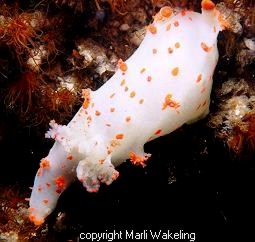
Dear Bill,
Here is a photo of Triopha catalinae.
These "clown nudibranchs" are very common on Vancouver Island, where they are found eating bryozoans and hydroids. I found one involved with a shrimp, cleaning its gills; the only time I have seen a commensal behaviour in B.C. [British Columbia, Canada].
Best wishes,
Marli Wakeling
President, 2000
Underwater British Columbia Photographic Society
scubamarli@excite.com
Wakeling, M, 2000 (Jun 4) Triopha catalinae from British Columbia. [Message in] Sea Slug Forum. Australian Museum, Sydney. Available from http://www.seaslugforum.net/find/2497Dear Marli,
Thanks again,
Bill Rudman.
Cnidosacs in Triopha catalinae
April 16, 2000
From: Ryan Murphy
Dear Dr. Rudman,
I am a student at Lester B. Pearson College of the Pacific, on the southern tip of Vancouver Island. I am interesting on doing my extended research/experimentation paper on the presence and use of cnidosacs in Triopha catalinae.
Unfortunately, I am not privileged to much detailed information on their physiology nor laboratory protocols in studying them. Though I do have easy access to a copious natural source of them at and surrounding Pedder Bay (go to http://www.racerocks.com).
Any information would be muchly appreciated,
Ryan Murphy
nichtsnutzig@excite.com
Murphy, R., 2000 (Apr 16) Cnidosacs in Triopha catalinae. [Message in] Sea Slug Forum. Australian Museum, Sydney. Available from http://www.seaslugforum.net/find/2265Dear Ryan,
I have seen photos of Triopha catalinae and indeed it would be a beautiful animal to work with. If you have any photos, it would be nice to have one for the Forum.
Concerning cnidosacs. Have a look at the page on cnidosacs and the page on aeolid cerata. I am afraid cnidosacs are found only in some aeolid families and the 'papillae' on the back of Triopha, although they look quite similar to those of aeolids are unrelated and quite different in structure and function.
Have a look at the Species List (see button in blue bar at top and bottom of each page) and look at some of the species in the family Polyceridae, and in particular the subfamily Triophinae, for some information on related nudibranchs. They are all bryozoan feeders so one possible aspect of their biology to look at would be to see how many species of bryozoans they feed on - perhaps only one? I don't know what your time frame is, but if you have a year perhaps you could have a look at the life cycle, when they breed, what their egg ribbons look like, do they have planktotrophic larvae, how much colour variation is there?
Very few nudibranchs are so well known that all these obvious questions have been asked and answered. If you have plenty of animals there are lots of basic questions to ask. Do they stay on one bryozoan colony until they eat it out, how long does it take them to kill a colony etc, etc.
I am not familiar with any study on the biology and natural history of this species, or any of its relatives, so any information you discover would be of great interest. If anyone knows of any such study could they let us know please? If you do decide to look into Triopha, please keep us informed of your discoveries, and any photos of it or other opisthobranchs from Pedder bay would be of great interest.
best wishes,
Bill Rudman.
Triopha carpenteri
December 23, 1999
From: Nicole
Hi, my name is Nicole and I am doing a science report. I was wondering if you could please email me some information on the Triopha carpenteri? I need the information before January 4th. If you could please email me something I would be very greatful.
Thank you again.
Nicole
Baby9871@excite.com
Dear Nicole,
In the past I have been fairly tolerant of urgent last minute requests to help with school work but don't you have at least a short break over the Xmas - New Year period? We have our summer holidays in the southern hemisphere and I am just preparing for about a month's holiday so I am afraid there is no way I can meet your deadline.
I suggest you look in a library for a good book or contact your local museum. I think the name used for Triopha carpenteri these days is Triopha catalinae (Cooper, 1863) so look for information on that species as well. Also have a look at the website Links Page for websites that deal with the west coast of North America (East Pacific).
Best wishes,
Bill Rudman.
